At this year’s DSEI in London, BAE Systems presented concepts for two new classes of warship that together could change the way the Royal Navy fights at sea.
The designs, a Future Air Warfare Command Ship and a family of Deployed Sensor Effector Platforms (SEPs), are being framed as a response to crew shortages, tight budgets, and the need to put more missiles into the air more quickly. In short, they would provide mass.
It is important to note that these vessels aren’t being pitched as ‘Type 83’ by BAE Systems. Instead, these are concept demonstrators for future distributed air warfare. What is notable is that the scale and mission profile of the concepts match closely with what the Royal Navy may eventually seek in its next-generation air warfare destroyer project.
At their stand, infront of the models of the evssels, I spoke to Steve Hart & Gavin Rudgley from BAE Systems about the problem their offering solves.
What’s on offer
The command ship would host the primary radar, the command function, and the ability to control smaller, distributed ships. “The air warfare command ship would be the ship that carries the main sensor capability, so the main radar, and has the command function that can identify targets and make effectors work, so missiles and so on,” explained Gavin Rudgley.
It would also carry a heavy armament. The design allows for up to 128 missiles, with additional space and power margins for directed energy weapons, decoys, automatic cannons and deployable drones. Although I’m keen to avoid ‘Top Trumps’ and point out here that this would entirely depend on the customer and what they want to do, the option is there.
Crewing is a major shift compared with today’s destroyers. BAE says the command ship is being designed for much less than 100 personnel, enabled by automation and redesigned internal systems.
I was told that one of the key lessons from Type 26 was the cost and complexity driven by its very demanding anti-submarine warfare role. For the larger air warfare variant, many of those requirements would be stripped back.
BAE explained: “A lot of the complexity in the platform is driven by the underwater radiated noise requirements. You don’t necessarily need that in an air warfare ship. What you can do is then take a more focused look on survivability… reduce your shock requirements to only the habitable areas, reduce your accommodation. So your accommodation is only working for the people that crew the platform. It gives you an overall cost improvement on the platform.”
In short, the larger design builds on the Type 26 family, but with the acoustic quieting, sonar and shock hardening pared away, producing a more affordable and mission-focused air defence ship.
The Sensor Effector Platform
If the command ship is the brain, the Deployed Sensor Effector Platform is the muscle. The concept is a 100m trimaran. Why a trimaran? I was told, “It has good sea keeping, low resistance so it gets good speed on low power, and it has the space and the deck area in the right configuration,” BAE explained.
Each SEP would carry 32 vertical launch cells, its own radar and guns, with options to containerise a towed sonar array for anti-submarine work. “So you’ve got enough room for the silos, couple of guns, bridge updates down, flight deck, and then you’ve got the aft deck. So that’s when we started thinking, well, there’s maybe not just air warfare. You could actually use this deployed sensor effector platform [for] ASW as well as air warfare.”
What was notable was that the platform is highly modular. As BAE told me, “a towed array, it can get fitted, containerised at the aft end… The inclusion of a towed array doesn’t actually interfere in the design with the inclusion of the VLS.” In practice, the same approach could be used to plop down containers carrying uncrewed air, surface or subsurface systems, giving the ship flexibility to shift roles between air defence, anti-submarine warfare or force support without altering the core hull.
Crewing is minimal: “Ultra-lean crew, six to twelve, potentially fully autonomous,”. Accommodation, if fitted, would be to commercial standards and removable in wartime.
Build times and industrial capacity
Speed of delivery is central to the SEP concept. BAE expects the vessel to be achievable in around two years. Referring to the design onw hich the hull form is based, I was told “the design period before we cut steel was about 12 months, less than that, and it was not a complex ship. Aside from the military fit, the ship itself… two diesel generators, single motor, full electric propulsion. Not a complex ship,” BAE explained. “The design time for the ship and the build time for the ship, less than one year to design, less than two years for build.”
Because the hull is closer to a commercial vessel than a full warship, BAE suggests it could be built in other UK yards, not just Govan or Scotstoun, with the company itself focusing on systems integration. “It would be of a more merchant ship style of manufacture… so you get your accommodation on it, for example, you can do to commercial standards. And then when you go to a point of war, you remove the people, and then you don’t have to necessarily have the same level of hotel services and survivability you need to have in a warship.”
The command ship, by contrast, would rely heavily on the investments already made in Glasgow. “The investment in facilities in Govan and Scotstoun are really the enabler for us,” BAE said, pointing to the Janet Harvey Hall and digital upgrades already supporting Type 26 production. The expectation is that lessons from the second batch of Type 26s will bring down build times for the command ship as well.
BAE sees capacity as a mix of dedicated facilities and enterprise partners. “We work quite closely with enterprise models where we have bottlenecks and we have pinch points,” the team explained. That could see yards like Cammell Laird, Ferguson Marine or Harland & Wolff take on block or hull work, keeping BAE’s main lines focused on high-end assembly.
Working together as a system
The crucial element is integration. The command ship would control four to six SEPs, directing their sensors and missiles through a shared combat and communications architecture. “We’re looking at interpreting the platform management system, combat management system, integration system and the comms system such that an operator can sit at a console on the command ship and eventually have… control over all the ship systems, directional control, the sensors and the effectors of the deployed sensor-effector platform,” I was told.
That distributed layout is intended to solve a tactical problem: how to maintain a high rate of fire against saturation raids. “It’s not the number of missiles, it’s how fast you can fire them into the air at the same time. If you put all your missiles in one silo, that limits how many you can direct fire. If you have multiple silos on different platforms, the rate of fire goes up, and that’s quite critical to the air warfare capability.”
It also reduces vulnerability by avoiding the concentration of effectors in a single hull.
Spiral development
BAE repeatedly stressed that this is not a single “big bang” replacement for Type 45, but a path of incremental steps. “Incremental spiral development, progressive transition into the future air warfare capability… it’s about delivering additional mass,” I was told.
That could mean deploying SEPs alongside existing destroyers first: “That could be a deployed sensor-effector platform for a Type 45 before it becomes the same for a future air warfare command ship. So you’re progressively increasing the air warfare capability of the Navy in a controlled manner, rather than waiting for a big bang and changing platform.”
Solving the problem
At its heart, the problem is one of numbers. The Royal Navy needs more missiles and more sensors at sea, but the traditional answer, new classes of large, complex destroyers, takes too long, costs too much, and demands too many sailors. I was told, “What this does is it gives you an ability to put more missiles to sea quickly, to move them apart from where your most central command platform is, so you’re less reliant on a single unit, and it allows you to then increase your effective radius, to give a greater layer protection of the force.”
This is not about magazine depth, the point is rate of fire. Modern air raids, as seen in Ukraine and the Middle East, involve large numbers of simultaneous threats. BAE’s point is that dispersing silos across multiple hulls is the only way to increase salvo size. “It’s not just the number of missiles, it’s how fast you can fire them into the air at the same time”.
I cannot stress this enough, but in my view, this represents a fundamental shift from thinking about destroyers as single points of defence.
The concepts also tackle the Navy’s manpower problem head-on. With recruitment targets missed frequently, lean-crewed designs are a necessity. By targeting fewer than 100 crew for the command ship, and as few as six for the SEP, BAE is offering a path to grow firepower without demanding a parallel surge in personnel.
Perhaps most importantly, these designs are achievable. They build on proven Type 26 architecture, strip away unnecessary complexity for air defence, and exploit UK shipyard investments already underway. The SEPs, derived from the Triton trimaran, are deliberately simple hulls that could be built in commercial yards in two years.
The command ship would flow naturally from Govan’s modernised production line. In an era of constrained budgets and crew shortages, that makes the pairing of a command ship and SEPs arguably the most credible solution currently on the table for the Royal Navy’s future air warfare requirement.
Future Air Warfare Command Ship
- Length: ~150–160m (depending on variant)
- Missiles: up to 128 VLS cells
- Other weapons: lasers, decoys, automatic cannons, drones
- Crew: potentially fewer than 100
- Role: carries main radar and command function, controls SEPs
- Build: lessons from Type 26 would give it a much reduced build time
Deployed Sensor Effector Platform (SEP)
- Length: ~100m, beam ~20m
- Hull form: trimaran
- Missiles: 32 VLS cells
- Other fits: guns, radar, containerised towed array, uncrewed systems
- Crew: 6–12, potentially uncrewed
- Build time: two years
- Role: distributed missile/sensor carrier, controlled by command ship
Disclaimer: Figures for missile load, crew size and build time are illustrative, drawn from BAE Systems’ concept briefings at DSEI 2025. Final specifications will depend on customer requirements and programme choices.


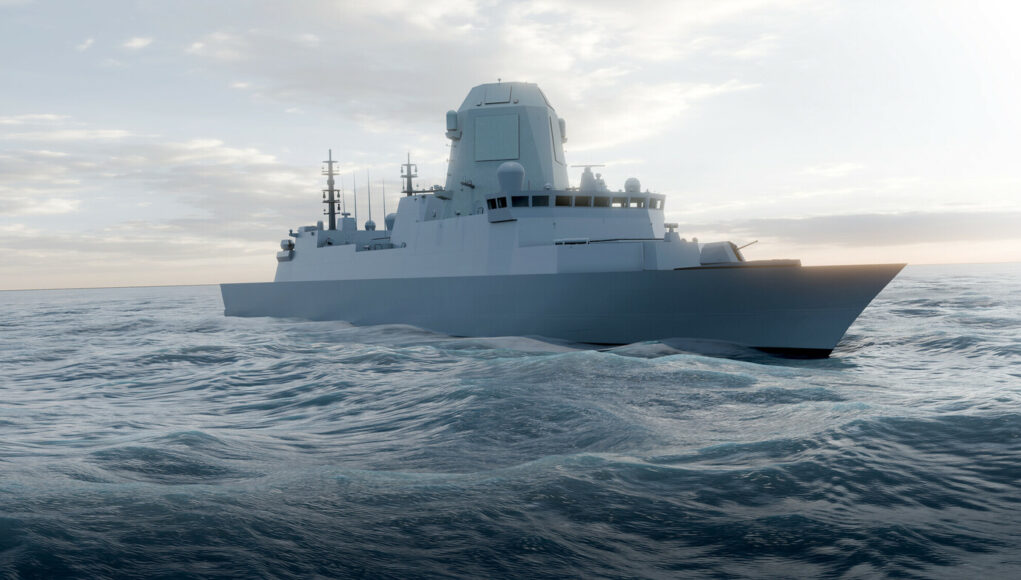
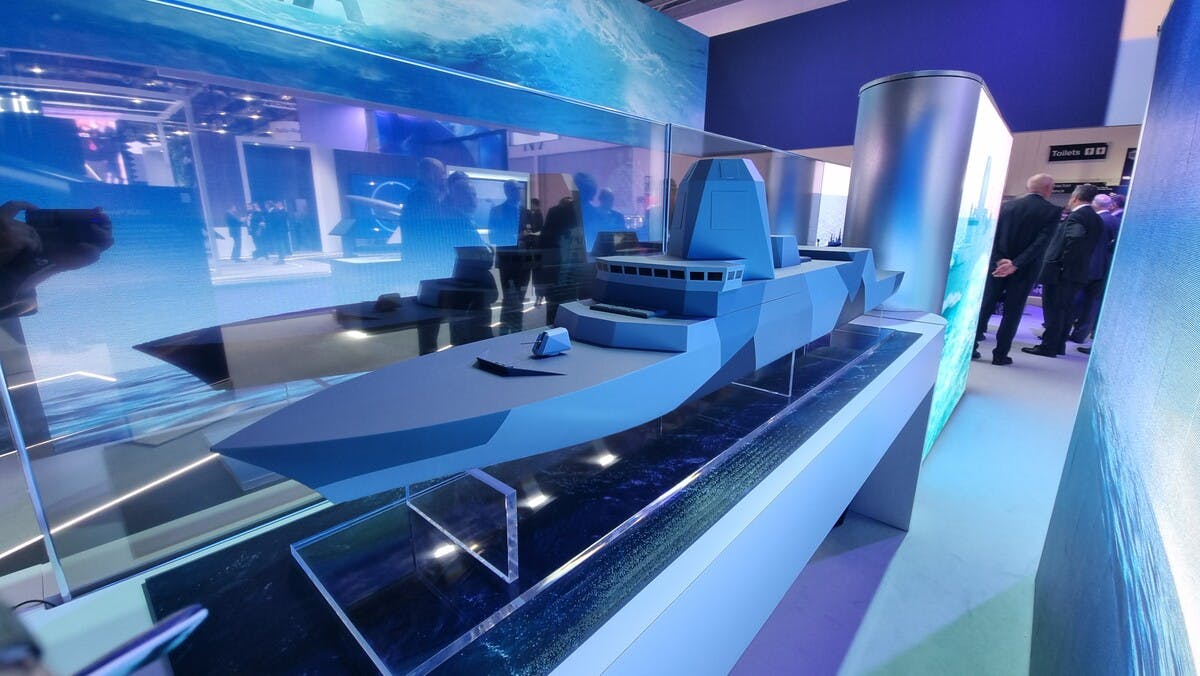





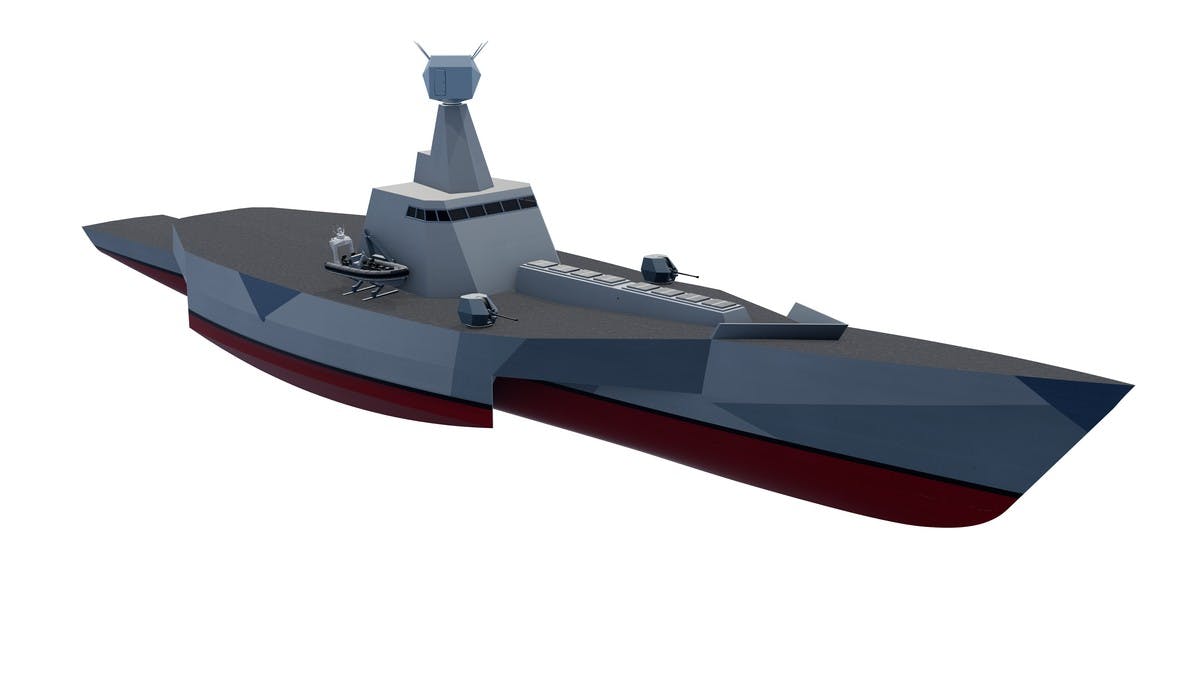
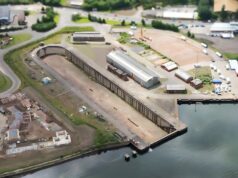
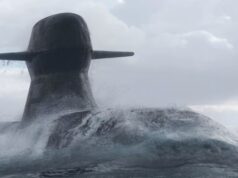
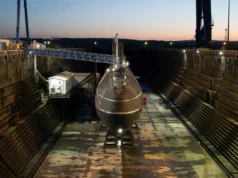
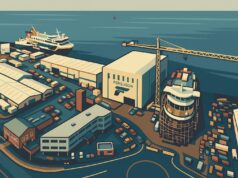
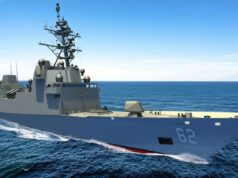
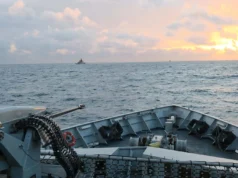

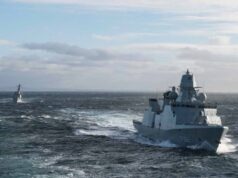
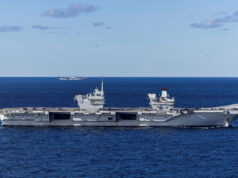
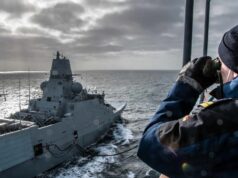

This really looks like the future, what would be the cost of a sep i wonder?
gtheyd be more like a missile corvette/sloop. id hope the final design would allow f fast production in reasonable numbers.
We went through the whole trimaran thing a decade ago and decided against it because for a given displacement a trimaran has comparatively little hull volume, so I’d guess SEP isn’t the future.
Anyway the cost tends to be in sensors and weapons primarily so I guess it depends on the final fit out.
With lean manning, much of the need for hull volme is reduced.
That’s not the reason.
Yes it is.
Just take a look at the pictures in the article. The volume on the trimaran 2 deck is huge compared to its displacement. And as I’m sure you know, #2 deck is the most popular deck for locating personal and equipment. And then there’s the opportunity (not exploited in the Triton design) for a full width deck structure which, once again, would be much more voluminous than an equivalent monohull.
There are a few solid reasons why trimaran were not persued for the Type 26 requirement, but lack of hull volume was not one and neither was poor seakeeeping.
Deck space is not the same as hull volume. I did a quick google and the internet disagrees with your assesment: trimarans have lower interior volume compared to displacement than traditional hulls.
Expect it to be copied.
I do wonder how much of the cost of war ships actually has any interaction in the design of the ship itself and how much comes down to the low slow order rate, pushing up costs to keep yards operational.
So, BAE are gunning for what many had already predicted – not a >10,000 ton multirole cruiser, but a cheaper, light combatant more in the vein of the current Type 45. Mass can then be made up with unmanned systems.
This approach has the advantages of being cheaper, easier to crew, faster to produce, whilst offering equivalent capability. But it relies on the RN, MoD and perhaps most importantly the Treasury embracing the entire system. Much akin to the issues that plagued the Type 45 programme, this approach could be vulnerable to a steady whittling down of its scope due to economic pressures. I worry that this approach will not lead to distributed lethality, but rather a watered down RN vulnerable to budget cuts.
The Treasury will see one for one replacement of the Type 45s as two Command Ships and four SEPs.
The primary problem with the T45 procurement were the massive cost overruns per ship – and understandably the Treasury wanted to cap costs to within the original overall project budget – Keeping on top of cost growth whatever is ordered is the key to maintaining the programme as planned.
I agree. Part of the process must be honesty and accountability from BAE and Babcock with regards to the costing of their proposals. Similarly, the MoD must ensure that contracts are signed and that the design is frozen as soon as it is suitable.
The Type 45 procurement report is a truly depressing read, although there is one thing it’s rather unclear on. The figure of total cost being £6.5b for the six ships, and that being £1.5b over “the original budgeted cost when the main investment decision was taken”, would imply an original budget of £5b – but given how often the report quotes that the original plan was for 12 ships, it’s unclear whether that “original” £5b was for the first batch of 6 ships (meaning the “main investment decision” referenced previously would be the signing of the first batch order), or if £5b was expected to cover all 12 destroyers.
A few rough calculations make development costs £2.4b, so 6 more ships should’ve cost roughly £4b. That’s either not terrible in terms relative to defence if there was allowance for a second batch with its own budget line, or nearly double if the budget was only meant to be £5b total.
The cost per ship excluding R&D as revealed in a Parliamentary answer, was 650 million. Didn’t stop Gordon Brown claiming a billion per ship savings by reducing the orders. Seeing that the 650million was an average, extra ships would have cost less than 600 mill each. Even less if Geoff Hoon had not insisted on the WR21’s.
It’s not likely the unit cost without the development cost would’ve come down much – most of the reason later ships are “cheaper” is because you’re spreading the development cost over a larger number of ships.
So £650m can be taken as the more or less baseline cost for subsequent hulls, with the R&D costs spread across subsequent hulls dropping from £400m for 6 hulls to £200m for 12. Final average price of a T45 comes to roughly £850m – if the original plan was £5b for 12, that’s still double the intended unit cost of ~£420m.
From an operational level, we can certainly condemn the Treasury and Brown for being short-sighted, but the truth is that the MoD fucked up the contract and programme, contributing to some massive and uncontrolled cost increases.
There was fixed budget allocated when UK was in HORIZON.
French didn’t want to use SAMPSON or the rest of PAAMS favouring their own tech as usual. In spite of initially agreeing to it.
So UK exited HORIZON and T45 became a thing.
UK were left to shoulder PAAMS etc and this did get a bit of extra cash but it was a very complex project.
I’d say £650m for what RN got was a bargain TBH.
Costs go down for #1 to #3 which is the learning curve and are pretty stable beyond that except if there is a bulk buy of motors/gearboxes/other bits that could get class costs down as per T31/26 now.
Bunkum. First of class is the most expensive and the cost to build decreases significantly for the first few ships. Averaging the first 6 ships of a build will result in a much higher build cost than the cost of the 6th.
This is shipbuilding 101.
* addressed to Callum
Respectfully, that’s far from always the case, especially with advanced platforms in that period. Look at the prices for the Astute class boats; boat 5 was the cheapest, with the last two actually increasing in cost. There are a variety of reasons that might happen, from economic factors to technical issues.
Look at what we know about the Type 45s. There was a lot of equipment not fitted to the first batch that the later ships may have built with; there were also a lot of technical issues that the second batch may have had corrected in build, making them more expensive.
The reality is, we don’t know what a B2 Daring would cost. They could have been cheaper, they might have been more expensive. The only figure we have is £650m for an individual hull before development costs; that’s the only number we can really use in any theoretical discussion.
More Bunkum. What we have is 650 million average for the first and only 6. The last ship in the order would cost significantly less than the first of class and therefore significantly less than the average.
And where does this Type 45 batch 2 come from? They were to be ordered as one batch as a class of 12. Then 8. Then 6.
You need to stop inventing history to support your erroneous beliefs.
What exactly am I inventing? I’m giving examples and referencing reports, your response is “bunkum, they’d be X amount cheaper”.
As for Type 45 batch 2, are you just being purposefully obtuse? Ships are often ordered in batches, as I’m sure you already know.
The first 6 ships were ordered together as one batch; per the MoD’s own reporting, the intention was to decide on the size of the second BATCH after 2005, although they settled on only 2 more in 2003. Have a read yourself, if you like.
https://web.archive.org/web/20120829024403/http://www.parliament.the-stationery-office.co.uk/pa/cm200102/cmselect/cmdfence/1229/122902.htm
Perhaps I’m not the one inventing history…
The cost overruns that sunk the Type 45 were with the PAAMS system and not the ship. Gordon Brown refused to fund the increase and cut the ship order.
In reality though, although it’s not great to have so few hulls, we had one tied up alongside for about 8 years because we didn’t have enough crew for her; would have looked even worse with 7 next to each other for want of sailors…
Looks like they are trying to keep as much T-26 into the design as possible. Even the missile load is the same as one of the options offered to the Australians.
Terrible idea, will only end up compromising the design.
I think the 8x mk41s upfront is new. The Hunter has 4x mk41s.
If looks right, it is right. This looks awful. Enough said.
I don’t mind it really, it has the same aesthetic as a lot of the 2000s-era GCS concepts with the fully enclosed bridge and flush deck.
We have to wait for the s…… To hit the fan as always .British history shows this and it’s a trend… Problem is in 1939 we still had lots of Ww1 cruisers and destroyers….. Now….. Well God help us….
That’s my view people on here will say AI will fix it all but that is bollocks.
We need ships and men making decisions at the right time.
Yes I think that’s the reality. Wake up, build more proper warships. Russia could be easily contained IF we get carefully kinetic to demonstrate they can’t win(we need stronger leadership), China has the largest navy & is also threatening expansion while attacking us in grey zone, Trump has derailed both NATO & the USAs role as stronghold for democracy, so can’t be relied upon, so we have the world descending into nighmare dystopia with our forces in the worst state for decades.
I just don’t get it. The solution to lack of hills and crew is to build something that is in reality a mini destroyer which has never been proven by anyone to be autonomous.
The much simpler solution is combine the leaner crew of newer vessels, they magazines of the rest of the taskforce, and the deck space of the replenishment ships and MRSS. All enabled by cooperative capability.
Fine to have very small, attributable drones, to extend the sensor envelope beyond the horizon or decoy or shadow or jam the enemy. But any task group in a high threat environment is going to have multiple crewed hulls with several magazines and flat deck space.
CBG will need at least two destroyers, two ASW frigates, and ideally two GP frigates, plus decks of the store ship and oiler.
ASW taskforce will need AAW area cover, but have it’s own magazines and replenishment alongside. Just tag a type 31 or two on.
Amphib taskforce will need type 26, 45/83 and tag on a couple of type 31 for magazine depth and some containerised missiles on the MRSS or replenishment vessels.
When would a type 83 not be accompanying other navy vessels with magazines, radar, point defence, deck space? It is not the offensive vessel. What is it providing area air defence for?
Stunning.
Triton lives again.
Again !
No surprise. It had many useful features and was ahead of its time I believe?
Haven’t a clue about any of that but I do remember reading something that said It was rejected as a hull form option for future frigates after much testing and evaluation.
So I guess it was not that bad given the statement about It’s sea keeping in the article.
Funny thing was, it was It’s Sea Keeping that seemed to be the Issue way back then.
Of Course I’m totally wrong because I’m no “Ship Designer”.
The US tested it in support of their trimaran platform so couldn’t have put them off. That said their Independence class has had its own problems but one presumes we would get feed back from those in return though with Trump or his successor nothing is particularly clear. It would certainly be an adventurous move. Too adventurous I wonder?
For the Literol domain, It was probably a good design but I do sort of recall there were comments made about the use the RN would put them to. Hence not taking it further.
It was a long time ago and probably before a lot on here were born or actually interested in such matters.
Sea keeping of a trimaran was never the issue with Triton with anyone that had a clue.
So you keep saying, in your own Grinchy way.
I guess you are a Naval Architect ?
I guess you’ve not noticed the dozens of trimarans that have sailed around the world in the most difficult of sea conditions.
I wasn’t the person who said it, I just remember it being said, years and years ago. You seem to just want to argue and assert your agressive nature here every single post.
It’s OK, I’m used to dealing with this sort of behavior, It’s easy to act that way on a site like this.
So, are you a Naval Architect ? You didn’t reply.
Now the question is, will BAE use Triton itself for the prototype? That would become a remarkable career.
Ha, good thought.
I’v seen reports that Triton is laid up in Hull but according to marinetraffic.com , she was in the English Channel as recently as a month ago.
Portland a month or so ago. Not sure where now.
It was a nice surprise seeing her there.
You could say…they’re Tri..it..on again!
That’s the spirit.!
A few years back the RAN or Aust Customs/Border Force had the Triton for patrols up North around Darwin area. No idea on how that went or information gathered but the Austal company here has quite a few catamaran/ trimaran type craft designs which they sell around the world including the US military.
I remember hearing that the T45 is so noisy the Russians can hear them without having to leave port. I wouldn’t fancy serving on a T45 with a torpedo in the water. Oh, I forgot. The T45 hasn’t got much of a sonar either, so you wouldn’t know it’s coming. Guess it aligns with government policy. Blissfully unaware and happy to save the cash.
The Type 45’s do have a basic Sonar set that to all intents and purposes is inactive. On the plus side, post PIP refits they may actually be a lot quieter than many would expect.
“may”
In fact, won’t.
Isn’t the T45 sonar used to warn of torpedos? Like to see some dual use torpedos used with SEA launchers on RN ships complementing the Ancilia decoys.
No because the sonars are not in commission at the moment.
Faster, leaner and more powerful…. That was me in my 20s…
Please don’t give the MOD any more options! They can’t cope with what’s in front of them now. Every new idea will simply add five years to the in-service date of something (anything).
What utter nonsense
Time will tell.
More like completely accurate than ‘total nonsense ‘ ,do try to keep up.
So the SEP is a bigger version than the PLANs JARI-USV-A.
I sort of like the idea especially if the SEP can be used as a patrol vessel as well.. being able to have the shipping container means it could carry the autonomous mine warfare systems, sub surface drone etc. having a patrol fleet that can immediately transition to a high risk peer war environment would be very efficient.
I agree Jonathan, a reconfigurable SEP would be a very effective tier 2 warship for independent patrols.
I love the whole concept to be honest. It will restore mass to the fleet.
Imagine 4 of these attached to a T31 on patrol in the Gulf.
All of a sudden, your lonely patrol frigate, becomes a task group packing a lot of firepower.
Excellent idea….
I get the concept, basically a loyal wingman for ships, but I still don’t see how these optional crewed vessels will work in a war. They will have to be fairly large to be able to stay with the “mothership” in heavy seas. But, if you are considering removing all the crew when some fighting starts, then who will do the vessel’s fire fighting, battle damage repair etc. So now you’ve built a fairly large and expensive vessel, that has a 32 cell VLS farm, where each weapon is at least £1M a pop. And expecting to use it as an attritable asset, just doesn’t sit right with me.
There are a number of factors of the Future Air Warfare Command Ship, that I believe aren’t correct. The primary one is the radar mast, which is very much in keeping with the Hunter class. But instead of a hexagonal mast, looks to be a four sided mast, where each face has a set of fixed phased array panels fitted. The larger one could be either a L or S band frequency panel. Whilst the smaller could be S, C or X band.
The T45 operates two primary radar systems, the L-band S1850M passive electronically scanned array (PESA). Along with the Sampson S-band, which is an active electronically scanned array (AESA), that uses two panels mounted high on the mast, mechanically rotating, but fitted back to back. The S1850M is a long range volume search radar, whilst the Sampson can do volume search, but is mostly used for target identification and tracking. Meaning the S1850M is predominantly looking up from the horizon towards low earth orbit altitudes. Whilst Sampson is looking at the sea towards the horizon and then upwards. As an S-band radar has a much better chance of detecting a sea skimming missile against choppy seas, as well as tracking it heading towards the ship.
Radar that uses electronic beam forming to control the scanning in azimuth and elevation, generally have a +/-60 degrees field of view limit in azimuth and a +/-45 degrees field of view limit in elevation. The min and max are taken either side from the panel’s centre boresight. Which is why the T45’s S1850M is tilted back to probably 30 degrees. Giving it an elevation capability of around 75 degrees. Otherwise if it wasn’t tilted, most of the capability would be lost as the beam will be looking at the sea. Lower frequency radars are pretty rubbish at finding objects against the sea’s background, especially when the sea is choppy. Sampson is also tilted back, but it is expected to look for anything that pops over the horizon, but also be capable of tracking that threat heading towards the ship against a choppy sea. So compared to the S1850M, it will have a much closer to the ship minimum view angle.
If we said that the radar panels in the above image operated over the same frequencies as the S1850M and the Sampson. Where the larger panel was L-band and the smaller was S band, then there is a problem! The larger panel is almost upright, meaning its ability to look up is severely restricted. Whilst the smaller panel is tilted to what looks over 30 degrees. Meaning it will stop tracking objects after they’ve popped over the horizon, as the beam won’t be able to depress far enough.
The other issue is that something like a single Spear-3 type weapon, would have the capability of taking out both of ship’s primary radars. As a strike to the mast has a good chance of damaging both radars systems.
To me the ship is lacking in kinetic firepower. The 57mm and 40mm weapons it has are too close range, unless the DARPA MAD-FIRES does see the light of day! It needs the ability to engage at a further stand-off distance, especially when dealing with a swarm of suicide drones for example. My solution would be the 5″ Mk45. As the USN are currently developing anti-air rounds for the weapon, specifically to counter drones. There would be no development cost as the rounds would be MOTS. But if considering BAe’s guided hypervelocity projectile (HVP) that is undergoing trials again with the USN. It has the ability to intercept air targets at 30 nautical miles (56km). Which is further than what is being quoted for CAMM-ER, but at significantly less cost and will have a much greater magazine depth.
Don’t get me wrong, I think the 57mm is still a good weapon system, but it should not be the primary gun system, but the middle layer. Additionally I would prefer that the ship had two of them rather than one, located so they gave an all round field of fire. Leaving the pair of 40s for the leakers and other smaller targets.
But there’s one key thing I think the ship is missing or not mentioned, which is a much larger hangar! For the role that this ship will conduct, the hangar should be sized to accommodate one medium sized crewed helicopter and at least 3 uncrewed VTOL aircraft. Much like the deployed sensor effector platforms (DSEPs), these uncrewed aircraft fitted with radar, ESM and EO turrets, would be used for extending the ship’s radar and visual horizon. Giving the ship an organic AEW capability, which would allow the ship to engage targets beyond the ship’s radar horizon. This is especially important when the ship is operating either on its own or is providing escort duty to merchantmen and amphibious ships, when there’s no carrier around. If the platform is similar in size to Leonardo’s Proteus with a 8 to 10 hour duration, then the ship will need at least 3, where one is flying, one is ready to fly and can take over to let the other return to the ship once on station, whilst the third is a reserve or could be used for other types of tasking. Proteus in its prototype guise has the ability to lift about 1000kg in payload. It could quite easily carry a pair of Leonardo Osprey/Thales Searchmaster ASEA radars, mounted back to back, that are mechanically rotated. Giving a potential detection capability out to 200 miles (370km). It should also be able to power them, when Thales quotes Seamaster only requires 2.4kVA to operate.
I feel that the RN are searching for the golden bullet, rather than concentrating on getting the basics right. As in, get the T83 so it can fully operate on its own without the DSEPs. Then include the DSEPs as an added bonus.
RE radars, are you suggesting that the better way round would be to have the mast be concave, where the lower search radars have a greater angle than the higher ones? And possibly also a system like the earlier BAE T83s, where the search radars are distributed around the upper superstructure? As an extreme form, I once saw a fan-concept of a CEAFAR fit where the usual hexagonal mast was split up into two triangular masts opposed by 180 degrees (to combine into hexagonal coverage) and placed in each of the radar mast slots on AH140. Always thought that would be a neat way of doing T83.
I think he means it should be a 6 sided setup like CEAFAR tend to use such as in Anzac & Hunter classes. 6 allows each panel to operate in its sweet spot & cover a missing panel if they have to. Also if you look at Hunter renditions, they have 4-6 (hard to tell) of what appears to be X panels looking almost straight up (I assume for BMD). Something you would expect any new design destroyer to have a solution for.
That wouldn’t help against the single strike vulnerability, though. If you imagine a fragmentation warhead going off in the middle of the composite mast, the radars on a Hunter could be largely knocked out.
If one radar panel goes out or is partially damaged can other panels overlap a bit? And is there a flat panel on top?
Hi Quentin, it depends on the azimuth angle the panels are fixed at on the ship’s structure. On the T83 concept above, each panel is set at 90 degrees to each, on the Hunter class they are 60 degrees to each other. Electronically beamed formed antenna array (AESA or PESA), generally has a field of view in azimuth of +/-60 degrees from the panel’s centre, giving a total field of regard of 120 degrees. However, as the beam sweeps past from the centre to the far left or right, the power of the beam drops off, imagine it like the positive part of a sinewave. This is due to less transmitter-receiver modules (TRMS) being capable of adding to the beam. Which is why most ships will opt for four panel arrays. You can get away with 3, but the extreme left and right will have a lot less beam power. It is also possible to go past +/- 60 degrees, but you enter the realm of diminishing returns, plus you will get more mutual interference, which takes more processing resource to remove. In essence for a four panel array, you can cover some of the area from a lost panel by sweeping further left/right by the two adjoining panels. This wouldn’t really work for a 3 panel array. But will be more effective for a 6 panel array as used by CEEFAR.
ON this new rendering, it doesn’t seem like there’s a panel on top to look directly up. But then the smaller panels on the top of the mast, look like they are tilted back to 40-45 degrees. Meaning they should be able to see above the ship. In earlier BAe renderings, they did show such a roof mounted panel.
DaveyB
I was referring to the Hunter class CEA radar re panels looking almost straight up (& appear to be X band). This air warfare command ship concept from BAE appears to have missed the mark when it comes to high end radar (or is that on purpose?).
Sorry DaveyB, replied before I realised you had responded further down.
Hi Torp, For me it would be better to split the panels onto at least two separate masts/structures, e.g aft/left and fwd/right, as this would give a degree of redundancy if the one mast is taken out. I’m not sure of a concave mast design, but the larger panels should be leaning back further to at least 20 degrees, as they should be scanning the skies above the horizon. The smaller panels should be leant forwards, but could be inline with the larger panels at 20 degrees. To cover the dead zone above the ship, a fifth panel could be fitted that lies flat, but looks directly up.
As DJ infers, this concept design does have elements of the Hunter class, where it concentrates all the CEFFAR L-band and S-band panels on one large hexagonal multisided mast. Which is a lot squatter (shorter) than previous renderings, perhaps to address the top weight issue. As CEEFAR with its L, S and X band panels is very heavy.
The new Hunter render also shows the mast dotted with lots of the X-band Seamount radars. including a ring that are set much like render of the T83 above. Where the panels are tilted back to what looks like about 45 degrees. But also includes a number of these panels mounted on the sides of the mast, enabling them to look at the horizon and down towards the sea.
The Hunter and this rendering of the T83 could suffer the same fate if the mast is struck by a weapon, possibly rendering the ship blind.
Hi DB, have you seen the reveal at DSEI of BAE’s ‘Artisan NG’ radar? It looks a bit like a cross between SAMPSON and NS100, (I think the only image of it on UKDJ was on the BAE T91 concept) and is a lot thicker, a bit like the rotating SPY-six (sry the six key on my keyboard doesn’t work).
I think Gabrielle Molinelli has the best pics on Twitter.
What do people make of the 32 cell layout in the SEP? It doesn’t look like the traditional 8-cell Mk41 modules. is that just an artefact of the model? I ask because 4×8 cell strike length Mk41 modules would cost about £40m per ship.
By appearance of the image it is 32mk41 but in an 8×4 instead of the normal 4×8. I’m guessing because it’s a trimaran so has a thin central hull.
I just didn’t know they made 2×2 modules.
According to Lockheed they don’t. Their 1 module option is still 8 cells
Might be a half mk41, 4 silo.
Just wait for all this to be copied….lol.
We should be buying mk57. Bigger, better, easier to implement and next iteration. If it is similar in price we should standardize now and future proof for hypersonics
I think the thought process that they are going down is the simple a very pragmatic one around the lethality of the environment, if modern major surface combatant gets hit by heavyweight Antiship missile or heavyweight torpedo even if it survives ( it will not survive a heavyweight torpedo) your chance of getting safely home to a port is low and even if you get the ship home it’s going to be well over a year before its seaworthy and probably cost many hundreds of millions to repair… essentially costing the same as building a new ship.
Just take USS stark when it was hit by two anti ship missiles, it survived only because it was in benign seas and the attack was in error so it was not followed up. It then cost 140million to repair in 1990 prices or around 340 million in today’s money ( more than the ship cost to build, as an OHP was a 120million ship)…your also going to suffer many dead and wounded…
In the Falklands with difficult seas and at threat of attack the RN simply abandoned badly damaged vessels to their fate.. to save the crews essentially.
So essentially if the ship is always going to be knocked out, will cost as much as a new one to repair and take at least a year to get back in service as well as costing you trained sailors and is likely to need to be abandoned anyway due to risk.. why not just buy cheaper disposable unmanned combatants.. that you can build in huge quantities in a short time.
That was a good read. If one panel goes out is there any overlap from the others because its looks a bit limited and any horizontal panel looking straight up?
Yes, because as everyone knows, ballistic missiles come straight down.
I agree that the whole concept doesn’t make a whole lot of sense until you look at the cost of the new radar. It’s going to be large.
So if you start from the viewpoint that the RN will only be able to afford a few of these radars, this idea emerges. Have 2 or 3 of the mothers and half a dozen of the drones.
Trouble is that the drones will quickly expand in size, capability, performance and complement just like the original Type 23 did. For excellent reasons. And the RN will end up with a quasi drone T45s without Samson.
Cost savings will be a wet dream.
Best to order pure Type 83’s with the magical crew saving technology to trim a few bodies, and swallow the billion pound cost.
There’s also four Dragonfire on this vessel giving coverage all sides. Can these also be manually operated and guided just by their EO? Any Anti-torpedo defence other thsn Ancilia? I can’t remember what country was working on it, maybe Germany or Italy (?) but dual use torpedos, in the sense of it also being an Anti-torpedo torpedo which sounds very useful to have to me especially if deployed in a TWS which I’m not sure if the RN is using anymore while other navies still are.
Does anyone else think that abandoning quietness, in the form of low underwater radiated noise, to keep cost down is cutting your nose off to spite your face? How will these noisy / less quiet vessels interfere with the ASW mission? How ill they operate as part of a task group while trumpeting their position to subs, UUSV’s or seabed sensor nets? Why do we need to go so far down the road of specialism to the point that when we design AAW oriented vessels, we just ignore that submarines even exist?
Oh yeah…… money!
On that topic, how much more does it really cost to make the accom for 15 people safe to naval fire and damage control standards?
To try to understand the thinking behind BAe ships would need to know the RN CONOPS, understand if defending large area, UK, against MRBMs such as the new Russian ~5,000 km Oreshnik Mach 10 plus with six MIRV warheads you would be looking something similar to the Japanese 16,000t plus ASEV destroyers to give it the necessary stability for its large SPY-7 radar, there is no so substitute for raw power for radar range as the fourth-order range law is applicable because the electromagnetic signal travels a round trip, with the power decaying as the square of the distance for both the outbound and return paths and you would be needing similar long range missiles as the SM-6 and SM-3.
Would have thoughtif the RN CONOPS is only for point defence of fleet from fast/hypersonic maneuvering missiles that could come in possibly at much lower altitude, with a radar horizon for a sea base radar to an attacking target missile at 40k feet the radar range is only roughly 50 miles and would require a faster new gen Aster 30B1NT type missile whose range perhaps be only 30 km against fast flying hypersonic missiles might be suitable?
Of course anti-ballistic missile will be part of the requirement. Jeesh.
The Sensor Effector Ship is very much in accord with the First Sea Lord’s speech, right the way down to the two year timescale, just missing the decoys the General spoke about. It’s almost as though 1SL knew in advance…. It will be interesting to see if it’s already deal-done behind the scenes while CDS was Navy, or if the new 1SL will have to try to get a fast spend on a new ship design past Knighton and Healey. Jenkins has a reputation as a shrewd government operator. Would he have announced getting one of these if it wasn’t already on the nod? Just one of course.
Whether BAES can deliver if they get the order is a different question, relying on commercial shipyards.
Is it not possible, if capacity is stretched to share the construction between Bae and Babcock? This certainly used to happen in the past where sister ships were not necessarily built by the same shipyard. I know it happened prior to WW1 don’t know how far, if at all that happened thereafter.
It was still happening in the 70’s and 80’s, but back then we were building 16x T42 destroyers and 14x T22 frigates. For the T22 Yarrow in Glasgow was the lead yard I think with Swan Hunter and Clammell Laird also building a few between them.
Cheers CR
The vulnerable part of the system is going to be the comms link between vessels.
After the Treasury of course.
And the RAF.
This is an interesting concept and one that could be using the T45’s until the Master Destroyer (?) comes to be built.
If I remember in 1945 the US Pacific fleet was beginning to look something like this with picket destroyers out in front. Also I think the Master Destroyer could be used as a Fast Transport with all that space and a very small crew carrying workshops and spares maybe other stuff.
Bread bin radar looks odd I must say.
“ The SEPs, derived from the Triton trimaran, are deliberately simple hulls that could be built in commercial yards in two years”
Given CSD says two years for the first in it is a fair assumption that Triton is the trials unit?
Otherwise BAE are saying three years – one design and two build…..
HI SB,
Unless the design is more advanced than we know. The language used seemed to suggest to me that it was already designed, but the timescale would require a commercial yard to get up to speed on a design and class they are not familiar with, even if it is designed (largely) to commercial standards.
So I think Triton might not be a bad shout as someone above suggested she was spotted in the Channel in the summer. If they are going to use her she’ll need a lot of stuff fitted and probably a refit after being laid up. They could forgo the missiles and just fit a secondhand radar for the trials as I think the main technical risk area would be the remote weapons control system and remote direction / AI stuff. So I think they would want to trial the data links and commuter systems on either end of the link and not just for the radar and engagement cycles, but for the engines (motor?), navigation (collision avoidance) and breakdowns and damage control. That’s is a lot of data across a very varied set of technical areas.
Triton was originally designed as a trials ship so not such a bad idea. I was with QinetiQ when they were trying to develop a business model for her, but could never make her pay. Seems she may have been ahead of her time. Hopefully, she was designed for an operational life of more than 18 years..!
Cheers CR
“ They could forgo the missiles and just fit a secondhand radar for the trials ”
Plenty of ARTISAN sets around from T23 and Albions. Related to SAMPSON so might be good for forming a battle space picture.
Agreed. BAE Systems have apparently been doing work on the networking systems so hook it up to an ARTISAN radar and start flying the odd drone around and see ow the system works. It will be interesting to see if anything comes of it or even if Triton is being refitted..!
According to Google AI RV Triton was reactivated in 2024 and moved to Portland, with some reports also suggesting she has been in Southampton and Portsmouth, so how knows.
Cheers CR
Listening to those with a lot of knowledge on these things I am heading towards having a bigger cheaper mother ship that we can have an elevated radar on. More elevation = greater distance of operation. Bigger the ship, more strike length silos mk57 instead of mk41.
Perhaps even a tethered radar
CEC is a must have
The ability to sustain its loyal missile ships with fuel and potentially containerised replenishment.
So we are looking at something like the proposed strike concept but without multiple helicopter a single chinook size deck and some RAS
Antenna height is less interesting for a radar designed primarily for anti-ballistic missiles. The the weight of the radar and extensive cooling systems, drags it down further.
The mothership will in no way be cheap. Very expensive radar and control systems before you even get to the silos, MT30’s etc.
Correct the mothership will not be cheap, but it will be cheaper than a destroyer.
I would target £1bn per squadron of.
1 mothership
8 Blackett class missile ships (containerised solution)
8 Herne subs
4 Atlas mine countermeasures
This means the mothership needs to come in under £500m probably will need a welldock or FLO FLO capability. Fueling capabilities and close in weapons systems would be a priority ( to keep usv assets on task longer) with a great radar, CEC & 5CISTAR capabilities.
Can this be achieved in the cost bracket – why not if we buy 8 squadrons worth. ( yes I know that is £8bn), which creates the tempo.
An updated Karel doorman JLSS (£400m) would be the base design for my model, morphing with the Canadian G-LAM Inc. its ice breaker hull
This doesn’t need to look amazing – it needs to work and containerisation may be the key to unlocking some capabilities at the required cost.
I wish I had some of that stuff you’re smoking. I’d make a fortune selling it on the streets.
This is absolutely radical and I hope it’s accepted by the Government and the funds are provided to make it happen. Changed times require a new approach. If this idea delivers more mass then I am all for it. I do have a couple of questions though.
1: If one of the roles utilised for SEP is to be ASW then how does this tally up with the simpler hull and machinery acoustics?
2: About the crews on the SEP.. Based on the idea that there would be a crew of Six, how will they be sustained while on task in terms of catering, medical health, general wellbeing, moral etc..?
3: Would distributed dock facilities, storage and shore support be required if these ships are to maximise availability in their area of operations, to enable them to detach from the task group to call into any suitably equipped UK port for resupply, crew change etc?
Diesel electric can be made pretty quiet. Of course the cost of something like Captas-2 being worked multistatic from three SEPs won’t come cheap.
As for the crew, I imagine rotation will be involved and the use of medical facilities on the command ship.
1. They don’t. It’s cow manure.
2. 6 is absurd, more cow product.
3. The proposed crew size wont allow for RAS or docking so refueling will be impossible. No doubt they will suggest nuclear power to solve the problem.
The solution will be AI powered RAS…..all with a nuclear power pack…..
Mind back to the real world you there might be a RAS team that is cabbed over….
Or just shoot them across with rockets like they do with the lines.
I also thought a new air warfare defence destroyer based on the T26 hull would be a good idea. Towed array or drone system could provide the ASW component every escort mus have. With such a tiny escort fleet we need every one capable of all tasks, not a handfull of each specialists. Lean manning worries me as you need enough crew on board to cope with casualties & battle damage, landing parties & prize crews etc. It is perverse that with a larger population than ever, a smaller fleet than ever, we can’t find crews for the remnant RN warships. Seen the experimental tri-hulled warship demonstrator in Gt Yarmouth harbour severeal times a few years back. Interesting to see it offered as the hull form for the 2nd design.
So if there’s three of the wingmen with the ship, based on the above we’re talking up to 224 missiles per group. If we then assume there’ll be six groups (not unreasonable on the march to 3.5%) then that’s 1,344 missiles. We’re gonna be buying a lot of missiles and maintaining a lot of missiles. Say 5,000 with a reserve and spares?
Underlying this proposal is the fear thatl as currently armed, conventional warships could be hopelessly vulnerable to swarm attacks by drones or missiles. But is the solution just to deploy ever more defensive missiles in numbers that require additional platforms? Maybe surface warships are no longer viable however much their sensors and weapons are improved. Combat aircraft need stealth and manoeuvrability to evade modern defences. Stealth has limited effect for warships which move no faster than they did in WW2.
Perhaps the future navy will be largely submarine with the surface fleet limited to constabulary operations by OPVs.
Even if that isn’t correct, yet, I don’t like the idea of spending vast amounts on ships that are one trick ponies. A smallish navy like the RN really needs to have multi purpose platforms ASuW, AAW, ASW
I tend to agree with that assessment, though I was concerned to read that some claim with the introduction of quantum based sensors in aircraft submarines will find it very difficult to hide. That said it can’t be worse that surface vessels and still more difficult to take out, mind you their cost I’d substantially higher.
I think this is a great idea. Western navies need to get away from building large, expensive ships and start developing large fleets of smaller but heavily armed ships. Large fleets, not large ships. We live in an age of missiles and missiles can be packed into autonomous or semi-autonomous vessels which can be linked together. When (not if, but when) you start losing ships losing these smaller ships won’t be as crippling to the war effort as losing a carrier or a guided missile cruiser.
Ship size has very little to do with saving costs or having a larger fleet.
It’s great that these new concepts are being discussed and aired. They do however seem a long way off!! Sounds like jam tomorrow to me. I would be more encouraged if somebody from the RN MOD or UK Gov were talking about releasing cash to fast track the build of Type26 & Type 31 deployment. If we need more bodies to fit them out then go get them JFDI.
I hear an awful lot of lean crewing and I suspect this is inevitable. My watch out is Human decision making however flawed is still paramount in a Theatre of War. Let’s not forget it was the OOW on Glamorgans bridge that ordered the turn to Starboard which probably saved her. Maybe AI will make the difference one day. But presently it’s Jolly Jack who still makes the difference!! BZ
Theoretically at least, AI is trained on the human experience and with only electrons and photons running through its veins it won’t get flustered when a split second decision is needed.
It’s great that these new concepts are being discussed and aired. They do however seem a long way off!! Sounds like jam tomorrow to me. I would be more encouraged if somebody from the RN MOD or UK Gov were talking about releasing cash to fast track the build of Type26 & Type 31 deployment. If we need more bodies to fit them out then go get them JFDI.
I hear an awful lot of lean crewing and I suspect this is inevitable. My watch out is Human decision making however flawed is still paramount in a Theatre of War. Let’s not forget it was the OOW on Glamorgans bridge that ordered the turn to Starboard which probably saved her. Maybe AI will make the difference one day. But presently it’s Jolly Jack who still makes the difference!! BZ
For Type 83, if anyone worries about the lack of acoustic quieting like that of the Type 45, I’m fairly certain the 80,0000 ton aircraft carrier they sail with is a bit of a giveaway regardless. So let’s crack on there.
The spiritual resurrection of RV Triton is a surprise to be sure, but a welcome one! The arguments BAE give for that are compelling, and also offset the lack of ASW measures in the T83 design.
Now for us to wait for the heat-death of the universe when the contracts to build are even drawn up (pessimism kicking in here).
So the command ship is the Type 83 with radar link involved, that being part of the FADS anyway. Low crew was always going to be a focus so hardly a BAE “Command ship special”. Also I know it was a first model, but those rear 40mm placements aren’t great, little line of sight. Side mounted, instead of front and back offers 2 180°, but the Burkes that mount their phalanxes front and back have 2 ≈ 240°. And personally the main gun should be the 5″ due to the new AA hypervelocity ammunition coming into service.
The SEP is just a revisioned arsenal ship idea. Receive targeting from the destroyer and carries more cells. I’m not sure whether 6 crew is good though, it’s so few you can’t do shifts, no cook and not enough for proper damage control, yet is still enough to be away from crewed ships. 15-20 is typically a minimum crew for those reasons, so crew them enough or just keep them autonomous. The trimaran design is also odd as the RN looked at them and ditched the idea because they offer a low volume to tonnage ratio limiting system than can be inside.
Having towed radar on the SEP is good though. The “command ship” (let’s face it, it’s a renamed Type 83) will be a couple miles away whilst on of the 3 is doing ASW and so won’t suffer as much friendly engine noise in the sonar.
But we’re still going to need a minimum of 8 destroyers as we’ve seen that 6 isn’t enough. The SEPs lack large radar so will need to be tied with the destroyer anyway. And the SEPs should be as cheap as possible but we need to understand they still won’t be cheap. The data uplink will be expensive, 32 VLS is pricey enough we decided to ditch it from the type 31 turning those frigates into less armed than a Visby Corvette. Current Type 31 is pathetically armed. And given the SEPS had guns a fire control radar will still be needed, not to mention a powerful enough engine to power the Dragonfire.
“The trimaran design is also odd as the RN looked at them and ditched the idea because they offer a low volume to tonnage ratio limiting system than can be inside”
Incorrect. Trimarans have high volume/displacement compared to monohulls. It’s one of their advantages.
Interesting idea the big dome does spoil the graceful lines of the type 26 Hull but there not there to look pretty I suppose!
It does state these are not intended to replace the type 83 though I still think that will be a big beast 10k ship to ride shotgun to the carriers we may only get 3 or 4 though due to cost and supplemented with this sort of idea.
Old 1930s destroyers were built as flotillas with a flotilla leader. I like this concept. Each type 26 or 83 would be not just a ship but a flotilla. 8 ASW flotillas. 6/8 AAW flotillas. Type 31 for GP roles. It becomes quite a fleet. Especially when combined with Atlantic net.
So just wondering… what happens to the drones and autonomous stuff when the Air Warfare Command Ship sinks?
Under the FADS, every ship will have the ability to contribute data and commands to the drones to certain degree. If the FAWCS is compromised, I imagine control of the drones will simply be handed off to another ship.
The other mentorship will be in refit.
*mothership
I meant to any ship in the fleet. We know the Type 26 frigates are expected to operate with up to three drone support vessels. I’d be surprised if the carriers for example lacked the ability to control those drones.
But these other ships won’t have the new radar(s) so will be rather compromised.
I was thinking more in an emergency capacity.
That said, I think that a wartime CSG would deploy with a pair of destroyers, so in the event of one sinking, control could be held by the other.
So just wondering… what happens to the drones and autonomous stuff when the Air Warfare Command Ship sinks?
More importantly, what happens when you are trying not to emit in order to hide fleet movements?
Surely the datalinks are directional to a certain extent? If we can build LPI radars, surely a steered beam could be used to communicate like Starlink uses?
The issue is how easy it is to pick up a faint signal a long way away.
Very good point.
Brilliant in theory but if the command ship was taken out wouldn’t that render the rest of the flotilla useless ?
That was my thinking- the rest of the flotilla could make attacking the command ship relatively more difficult than just attacking a T45 in isolation, but once you’re going down the ‘networked system of systems’ route it would surely make sense to try and distribute everything rather than having single points of failure (like the radar). Ideally keep the humans completely out of harm’s way too.
I’d expect all major surface ships would have some ability to control the drones in an emergency.
This is what happens in Stargate Universe lol. The characters aboard the starship Destiny are pursued by relentless alien drones programmed to destroy all technology that isn’t theirs; while the drones can be fought and destroyed it’s costly, damaging and dangerous, so the team targets “control ships”. Taking one down nullifies all the drones at once.
Just to indulge my geek side, there’s a similar scene towards the end of Star Trek DS9 where Cardassian turret satellites automatically target enemy ships, but the Defiant crew are able to fool them into attacking their own side. This is BY FAR the biggest risk of using uncrewed military vehicles IMO.
Shock applied only to habitable areas? Really? The Command Ship will need similar levels of survivability as the T26, although URN could be relaxed. The good news is that, since BAE have done it very well, it should be straightforward and not expensive to do. The Malaysians got very survivable ships for next to nothing as their frigates were designed and built at the same time as T23 – the Malaysian frigate designers just used the same standard, equipments, mounts etc. as they were already applying in T23. No measurable impact on cost (I was told by a BAE colleague). No reason why that shouldn’t be the case now.
I read this as “United Kingdom announces a concept that China is already building and putting into service”
Then you need a trip to Specsavers
You need a trip to charm school !
Just sayin.
Anyway don’t fret, Christmas is on it’s way, you can be as grumpy as you like then. 😁